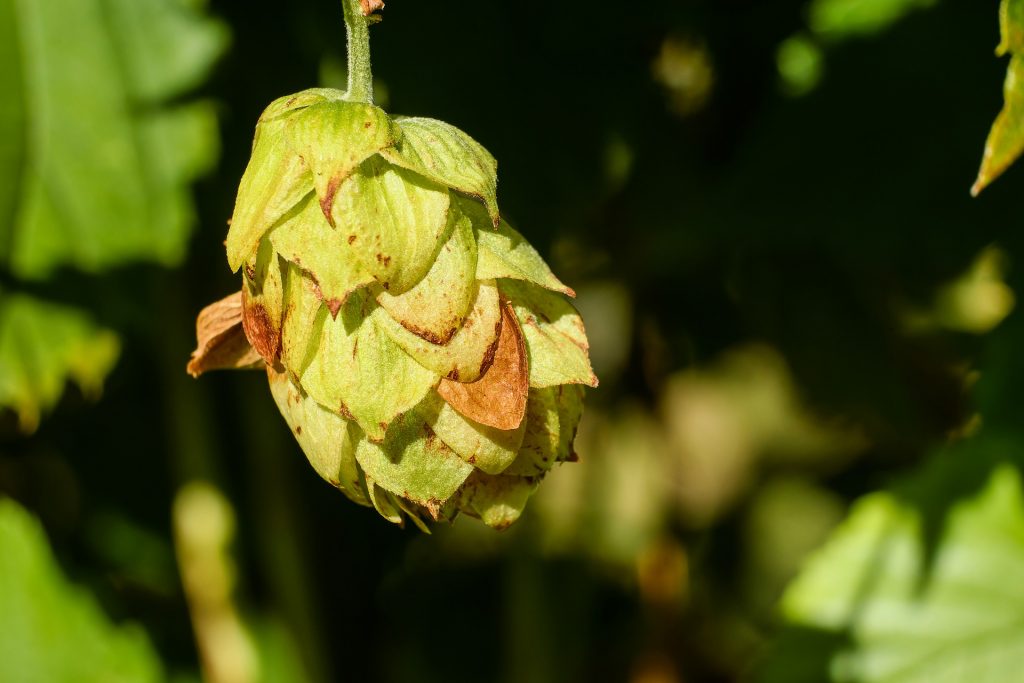 Hops (Humulus lupulus) is perhaps not the most well known herbal remedy. This is reflected by the relatively low number of scientific studies that have documented its effects. However, hops is widely known to be used in the brewing of beer, where it is used as a flavouring agent. In traditional medicine, hops is used as a sedative and calmative agent, and in this regard is often found administered in combination with other herbs. In particular extracts of valerian and hops have been formulated and have a long history of use in traditional medicine as a treatment for insomnia. Hops is a perennial climbing plant that grows to around 2.5 meters in height often up trellises. Hops is found widely distributed around the world, and is grown on a large scale commercially for beer production in many countries including the United Kingdom and the United States. The part of the hops plant that is used for its beneficial medicinal effects and for brewing are the hop flowers, which resemble pine cones in shape.
Hops (Humulus lupulus) is perhaps not the most well known herbal remedy. This is reflected by the relatively low number of scientific studies that have documented its effects. However, hops is widely known to be used in the brewing of beer, where it is used as a flavouring agent. In traditional medicine, hops is used as a sedative and calmative agent, and in this regard is often found administered in combination with other herbs. In particular extracts of valerian and hops have been formulated and have a long history of use in traditional medicine as a treatment for insomnia. Hops is a perennial climbing plant that grows to around 2.5 meters in height often up trellises. Hops is found widely distributed around the world, and is grown on a large scale commercially for beer production in many countries including the United Kingdom and the United States. The part of the hops plant that is used for its beneficial medicinal effects and for brewing are the hop flowers, which resemble pine cones in shape.

The main medicinal use for hops appears to be its sleep inducing effects. These effects are possibly brought about through interaction with the melatonin system in the brain. Both hops and melatonin cause a decrease in body temperature, and this hypothermic effect is a requirement of the induction of sleep. Hops is available commercially as decoctions (tea) and as capsules. Both of these methods should produce the sedative properties of the herb. Hops is often given in combination with other herbs. For example a valerian and hops combination is traditionally used as a sedative in herbal medicine.
The active ingredient 2-methyl-3-buten-2-ol is perhaps responsible for the sedative effects of hops. Studies indicate that constituents of hops may bind to melatonin and to serotonin receptors in the brain. Therefore the action of hops may be through changes to the serotonin and melatonin levels in the brain. Melatonin is the hormone responsible to inducing sleep and maintaining the correct sleep-wake cycle. Serotonin can also be converted to melatonin. Therefore modulation of the melatonin and serotonin systems of the brain may explain the sleep inducing effects of hops. Some evidence also suggests that a component within hops may bind to the benzodiazepine receptor. In animal models, hops has been shown to have hypothermic, analgesic, anticonvulsant and hypnotic effects. Of these effects, the hypothermic effect is particularly interesting because this effect is similar to the hypothermic effect induced by melatonin, and is a requirement for inducing sleep. This may suggest that hops is able to regulate the sleep wake cycle.
Eat Well, Stay Healthy, Protect Yourself
RdB
